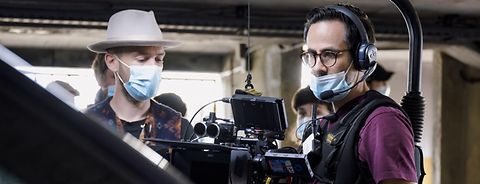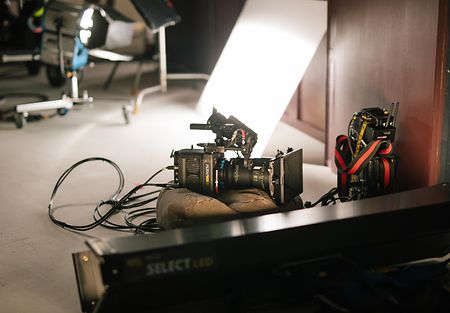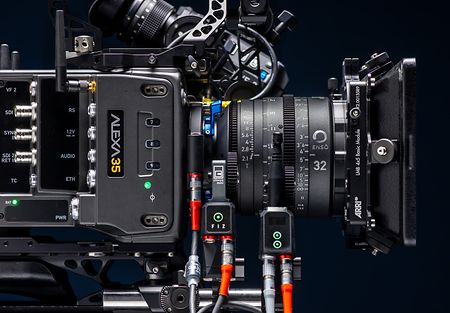A great success in theaters in France with 2,400,000 admissions, “November” is the latest feature film by Cédric Jimenez, director of the highly acclaimed “Bac Nord.” The dense thriller “November” tackles the terrible Parisian attacks of November 13, 2015, which left 130 people dead and 413 injured. To film the urgency of the investigators’ pursuit of the terrorists on the run, the director called on cinematographer Nicolas Loir. In an interview with ARRI, the DP explains his technical and aesthetic choices to bring this high-tension epic to life.
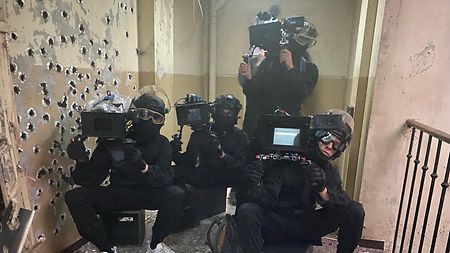
Cameramen during the “final assault” scene (from left to right): Clément de Hollogne; DP Nicolas Loir, Thomas Burgess, and director Cédric Jimenez
How did you approach this project about the aftermath of the November 2015 attacks in Paris?
From our first meeting with Cédric Jimenez, we talked a lot about the script and how we felt when we read it, especially the tunnel effect described by the investigators. Like many people, we were touched by the November 13 attacks. Throughout the shoot, the director and the whole team were focused and very respectful of the subject. There was a sort of severity. Cédric Jimenez wanted to make a modest film. It was not a question of building an ostentatious image, but of creating an aesthetic proper to the film. Among the director’s references were Jean-Pierre Melville’s “Army of Shadows,” the photos of Nan Goldin and Harry Gruyaert for the depth of their colors, the films of Michael Mann, Paul Greengrass, or Kathryn Bigelow’s “Zero Dark Thirty” with its naturalistic but very worked side. My bias was to create a contrasting image, dark, but with color. It’s a fairly naturalistic aesthetic, but more dense than in real life. The exchanges with set designer Jean-Philippe Moreaux and costume designer Stéphanie Watrigant were very important. We created a color palette with a lot of blue and orange tones. For the big police office, we did some tests on the walls to get a more or less gray blue. We also added very precise color spots in the set with desk lamps. We were trying not to be monochromatic. “November” is a night film, but it’s not desaturated.
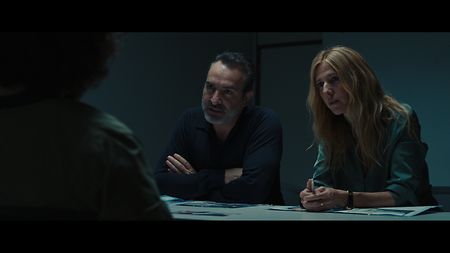
Scene from “November” with actors Jean Dujardin and Sandrine Kiberlain
Why did you choose the ALEXA Mini LF?
I didn’t do any comparative camera tests on “November.” I had already used the ALEXA Mini LF in commercials and I really like it. For me, it is the direct continuation of the ALEXA Mini. I like its softness in the rendering. It also allows me to gain subtlety in the colors thanks to its larger sensor. It’s a real improvement over the Mini. In its digital cameras, ARRI has always favored sensitivity over definition. I really like that. You get the full benefit in color rendering. The high sensitivity of the Mini LF in low light was also very useful for me on the night scenes of “November.” I’m particularly thinking about the final assault on the terrorists. I had just ten SkyPanel S60s installed high up, instead of streetlights, and their power was enough to light a 300 meter long street. This was especially important since we only had four or five hours of night to shoot the exteriors. Another strong point of the ALEXA Mini LF is its compactness. As I was shooting a lot of handhelds on this film, this was a determining factor.
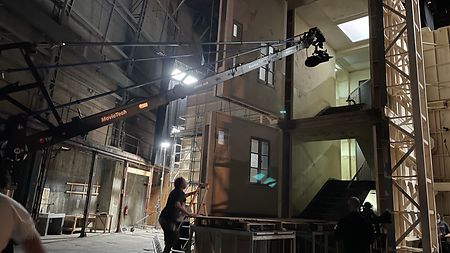
Building the scene for the “final assault” in “November”
How did you use the camera on “November”?
I set the ALEXA Mini LF to 4.5K at 2:39 aspect ratio. This is one of the modes offered by the camera. We felt that over-definition was not necessary on this film. At the sensor level, I just kept a five percent margin so I could crop or stabilize. I exposed the camera to ISO 1280, 1600, and 2500, even in daylight scenes, so as to put some texture back into the image. I find the ALEXA a little too smooth at ISO 800. However, I like how it reacts when pushed to high sensitivities. We also had a LUT for the dailies and the on-set returns, which we had prepared beforehand with colorist Mathieu Caplanne. As for the lenses, I did a lot of comparisons before deciding on the Blackwing Tribe 7s. They have a very interesting roundness, close to ARRI Rental’s Prime DNA lenses.
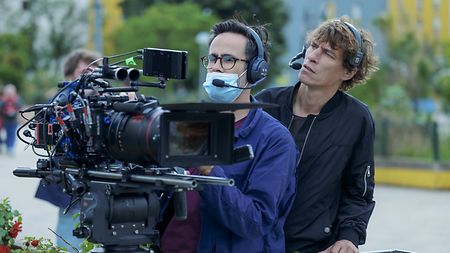
DP Nicolas Loir (l.), director Cédric Jimenez, and the ALEXA Mini LF on set of “November”
There is a constant energy in the film. How does that translate into your work?
When I read the script, I had this sense of urgency that grips the investigators throughout the story. And you can feel it in Cédric Jimenez’s direction. He instills a permanent energy on the set. His way of working is based on movement, and he likes to give the actors great freedom. This has direct implications on the lighting design. Above all, Cédric wanted to shoot the entire film with two cameras simultaneously. It was a serious challenge for me and the whole technical team. I questioned myself a lot about how to do it. However, on set, I immediately saw the benefit that it brings to the actors. In concrete terms, I had one ALEXA Mini LF on my shoulder and the other one operated by Thomas Burgess on a Steadicam, a dolly, or handheld. Shooting with two cameras allowed Cedric to go fast, to give a pace, an energy, to the film. He takes everyone with him. Everything is very fluid. When the shot is good on both axes, we can quickly change the value of the shot. It’s very efficient, even though it’s a big constraint for the image team. I still remember the final scene between Anaïs Demoustier and Lyna Khoudri which was particularly intense in terms of acting. It’s the same shot in both axes that was kept in the editing. Moreover, this is a challenge that has followed me on other films where I now propose to shoot with two cameras if the scene requires it.
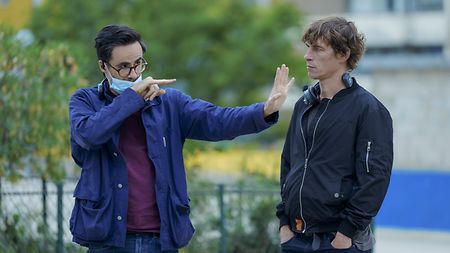
DP Nicolas Loir (l.): “The ALEXA Mini LF allows me to gain subtlety in the colors thanks to its larger sensor”

Director Cédric Jimenez and actress Anaïs Demoustier on set of “November”
The exterior scene with policemen observing the terrorists under a highway bridge is impressive, very dark, and yet we perceive everything. How did you light it?
This scene is shot with the ALEXA Mini LF set to ISO 2500. It is actually close to the cut initially planned by Cédric. I installed SkyPanel S30s in place of the existing lights and reinforced the brazier with SkyPanels programmed for flame effect. I also installed SkyPanel S360s far enough away to give the trees some shine. The sequence remains very dark, but we chose to show the important things to viewers. This is the exact opposite of the opening scene in Greece which is flooded with sunlight. Cédric’s idea was to contrast with the rest of the film, which takes place in November in Paris. In Athens, I played a lot with the shooting schedule to have the sun in the right place depending on the shots. In the interiors, I worked with the decor to make certain windows more dense, paint the windows, or add newspaper.
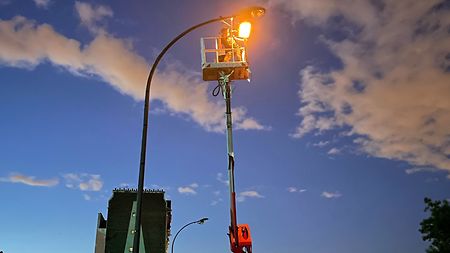
“I had just ten SkyPanel S60s installed high up, instead of streetlights, and their power was enough to light a 300 meter long street,” explains DP Nicolas Loir
The critical and public success of “November” must have given a new dimension to your career. What are your projects today?
“November” has been a great experience and a milestone in my career. Today, I am offered more important films. I recently finished shooting “Soudain, Seuls,” the new feature film by Thomas Bidegain, with Gilles Lellouche and Mélanie Thierry. It’s a survival drama that we shot in Iceland with the ALEXA Mini LF. The film is dark, exciting to illuminate, with a lot of natural light and often a very low sun. In some scenes, the actors are only lit by a campfire. Here, the Mini LF allowed me to get a lot of detail in the highlights.
After “November,” I shot “Je verrai toujours vos visages” by Jeanne Herry, which deals with restorative justice. It is an author’s film on resilience, which will be released on March 29. I am very proud of it. It was an exciting experience in terms of image, with very subtle work on the faces. During the preparation, the director told me that the faces are the film’s landscapes. There too, I shot with an ALEXA Mini LF. The camera adapted very well to these three very different projects.
At the moment, I’m using the new ALEXA 35 on an ADP commercial. We are shooting at night on the runways of Roissy airport without much additional light. The sensitivity of the ALEXA 35 is impressive. I use the camera set to ISO 6400 ES, with an Angénieux zoom lens that only opens to 2.6. The play of textures is very interesting, and the grain increase appears well controlled.

Cinematographer Nicolas Loir with the ALEXA Mini LF on his shoulder on set of “November”
